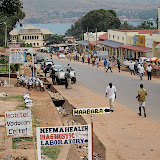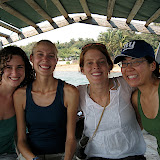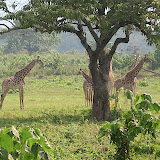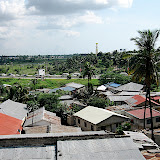We went to Gombe. At around 11 on Saturday morning, we got a call from Betsy and Molly’s colleague saying that he had arranged a boat from the hospital, and we should meet the driver at noon to make arrangements. We walked into town, arranged for the boat to pick us up at 3pm, paid him, and were set to go. It seemed ridiculously easy after all the work we’d put into going during the week.
At 3pm sharp (the first thing to happen on time ever in Tanzania), the boat pulled up behind our hotel and we loaded it up. The boat was a little rickety – it used to be the TB/Leprosy boat for Maweni hospital – with a only a minor leak that kept one of the crew busy scooping out water for a good half of the journey and filling in minor holes (with wool pounded in using a screw driver and a rock). Since the boat was named Survival and there were life jackets on board, we weren’t too worried. The journey took about two hours, and was beautiful. We passed small little villages on the lake, and watched the landscape turn from the red dirt and palm trees we know so well slowly to forest and then dense forest. We arrived at Gombe and were taken to the Rest House, a small but great green building with an open air wraparound living room (with screens and mesh to keep the baboons and mosquitoes out) and two bedrooms with two big beds each (which felt amazing after sleeping on my smaller than a twin bed for the last month). We made arrangements for our treks the next day, and then Anton, the director of JGI showed up. He welcomed us and insisted on having his cook come and get all of our food to prepare our dinner for us. He’s an amazing man – very accomplished but so calm you always feel very at ease with him. We went for a long walk on the beach and short swim, and then headed up to Anton’s house.
Anton actually lives in Dr. Jane’s old house that she built in 1973 when she started doing research. It’s a really cool open air house (with screens of course) that was completely candle lit when we arrived. Anton showed us a large poster with all the different monkeys of Africa, explaining which ones were located in Tanzania and tons of interesting facts about them. He also showed us a bunch of skulls of wild pigs, monkeys, and baboons, telling us about their teeth and how they are used, the size of their eyes and how you can tell if they have depth perception. We were joined by Mark, a University of Minnesota student who is doing research for six months at Gombe. We drank the wine we had brought with us (an actually decent Merlot from South Africa that’s only about $6) and talking about life in Gombe and Kigoma. Then we had a delicious dinner and said our goodbyes. Before we went to bed, we went out to look at the stars, which were amazingly bright since the moon hadn’t risen yet. I saw a falling star just as we went inside.
We got up bright and early this morning and had breakfast (boiled eggs on bread… yum). Anton was nice enough to give us a thermos of hot water and instant coffee (I’m not sure how much caffeine is actually in it, but it makes the mornings a little easier). The baboons started coming out around breakfast time, and started walking around our little house. It was crazy being so close to them! We saw a cute little baboon hanging onto its mother’s back.
Anton met us and escorted us up to the park office, where we met our guides. Our plan was to hike to a few areas and try to spot chimps, (which is actually a little difficult – a lot of people come all the way to Gombe and never get to see any), then hike up to the waterfall and then further up to Jane’s peak. We started hiking along the forest, which was incredibly beautiful, and stopped at the feeding station. When Dr. Jane first came to Gombe, she had a hard time finding the chimps. Since they were raiding the local food stores and stealing bananas, she figured out that they really liked them. So she built a little house a little ways into the park and laid out bananas so the chimps would come near her, and started observing them that way. The guide was a little ways into telling us this, when the other guide pointed up and said “chimp.” We looked up, and in the tree above us was a small chimpanzee. It was wild! We stood there watching him eat leaves, taking a gazillion pictures, when we noticed an even bigger chimp a little higher up. All of a sudden Anton showed up, and started telling us the names of the chimps, and that they were both males. The smaller one was a younger male who was doing active idol worship – following around the bigger male and imitating him, learning his mannerisms. Then a mother and her child showed up on the other side of us, the mother grooming the baby. The males climbed down from the trees, and the mom and the baby walked across in front of us, and the whole bunch moved down the path. Anton motioned for us to follow them, which we did for a ways. He said that it was a mother and her child, and the mother’s brother. We watched them chill and groom each other. It was very surreal, standing there watching the chimps with the director telling us all about them. Crazy.
Then we hiked up a little farther to watch another family. They were really high up in the trees eating, and we waited for them to climb down, but they never did. We decided to hike for a while and come back later. We hiked to the waterfall, where Gombe stream cascades down for 25 meters before continuing onto the lake. Gorgeous. From there, we hiked for about 30 minutes up to Jane’s peak. This is where Dr. Jane hiked to every morning at sunrise, because you can perfectly see the two valleys below and she could see where the chimps were to follow them. We were amazed that Dr. Jane is 74 years old, and when she’s at Gombe she still hikes up it every day, because it’s a steep climb. She’s an amazing woman, for many reasons. The view from Jane’s peak was incredible – the valley of forest spreading down below us and continuing all the way to the lake, which is so large you can’t see across it. Our guides pointed out a few old chimp nests. We sat up there admiring the view and feeling like the only five people in the world for a while before climbing back down. We tried to find the family that we were waiting for earlier, but they had apparently climbed up to Jane’s peak while we were climbing down, so we missed them. We didn’t really mind, seeing more chimps than most people ever get to see, and very close up, so we hiked back down to camp. Also walking through the park we saw blue monkeys, baboons, and many different kinds of butterflies.
After a yummy lunch of crackers, avocado, and cheese (we found one shop that has what we assume to be very very old cheese, since Tanzania doesn’t have cheese, but that tastes delicious anyways), we all jumped into the lake and swam for a while. The lake is so huge that the water is wonderfully clean, so you feel really rejuvenated and clean when you get out (cleaner than we feel after we take a shower at AquaLodge, where the water is dirty and the water pressure isn’t enough to get your hair completely wet).
We stopped at Anton’s house before we left to say goodbye and thank him for his hospitality. He was very kind to us during our stay, and after such an incredible 24 hours we were really sad to leave. It felt like paradise, or like we had discovered the fountain of youth. We just felt so clean, inside and out, and re-energized. The fresh air, hiking, fresh water, and good food did us all a lot of good since we were a little rough for wear after the last month. The park is one of the most peaceful places I’ve been to in my entire life. We had another nice boat ride home (although we all fell asleep for a while), and came back buzzing from our incredible trip. We felt like the luckiest people in the world, experiencing what few people in the world have experienced, and being lucky to share it together. We went and had a great meal at Gibbs to finish off such a wonderful weekend.




 postpartum hemorrhage (PPH). Misoprostol is a drug that makes the uterus contract, and can be used to either treat or prevent PPH. Since it is relatively inexpensive, stable in field conditions, and does not need to be administered by a health worker, it's ideal for resource-poor settings such as rural Tanzania. Misoprostol has been used for a few years in the region, and along with a fellow intern I will be conducting questionnaires, in-depth interviews, and focus groups with women who have used misoprostol, traditional birth attendants (who have been delivering the drug), and doctors/midwives to learn more about how misoprostol is viewed in the community and by women who have taken it, it's effect on maternal mortality, and barriers to its use.
postpartum hemorrhage (PPH). Misoprostol is a drug that makes the uterus contract, and can be used to either treat or prevent PPH. Since it is relatively inexpensive, stable in field conditions, and does not need to be administered by a health worker, it's ideal for resource-poor settings such as rural Tanzania. Misoprostol has been used for a few years in the region, and along with a fellow intern I will be conducting questionnaires, in-depth interviews, and focus groups with women who have used misoprostol, traditional birth attendants (who have been delivering the drug), and doctors/midwives to learn more about how misoprostol is viewed in the community and by women who have taken it, it's effect on maternal mortality, and barriers to its use.